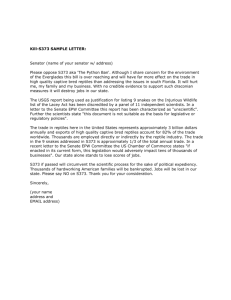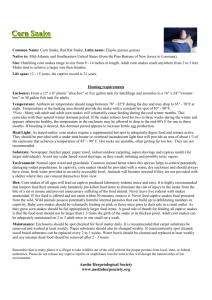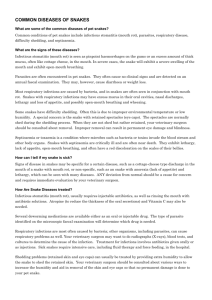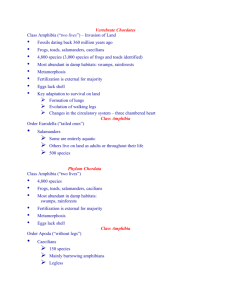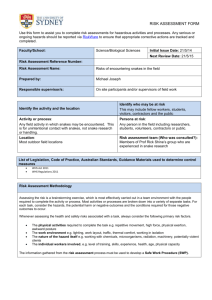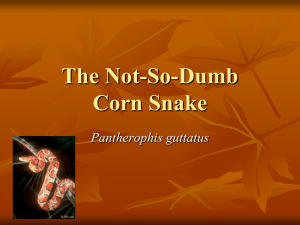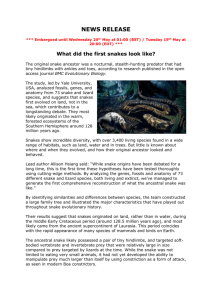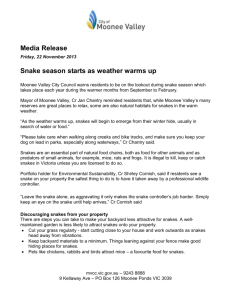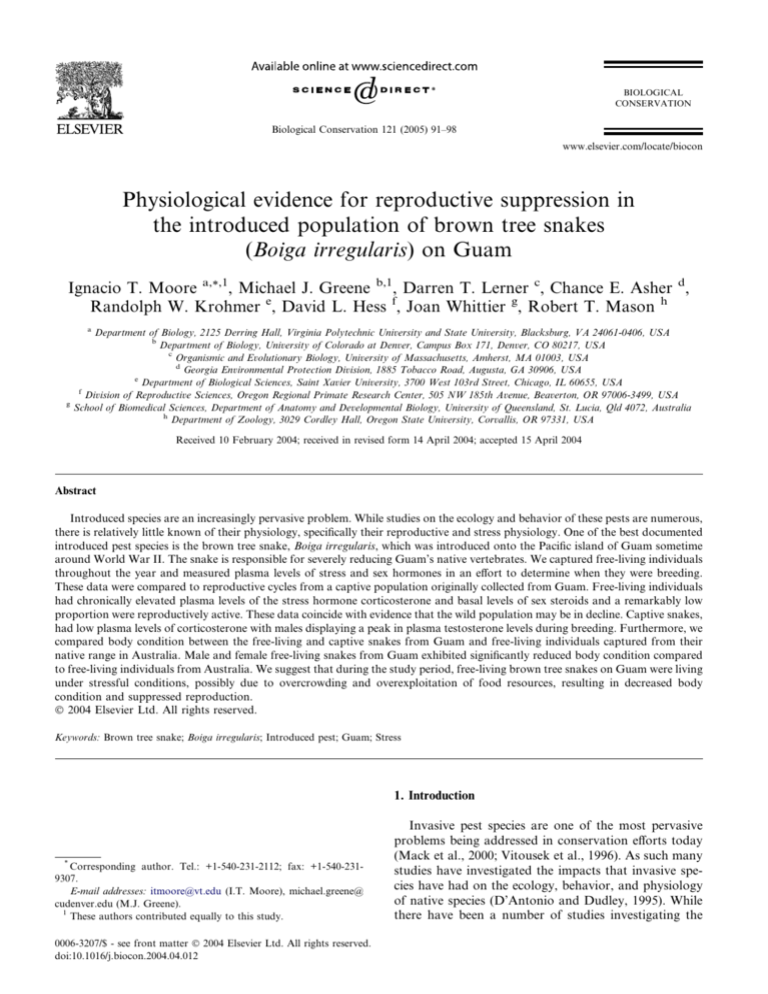
BIOLOGICAL
CONSERVATION
Biological Conservation 121 (2005) 91–98
www.elsevier.com/locate/biocon
Physiological evidence for reproductive suppression in
the introduced population of brown tree snakes
(Boiga irregularis) on Guam
Ignacio T. Moore a,*,1, Michael J. Greene b,1, Darren T. Lerner c, Chance E. Asher d,
Randolph W. Krohmer e, David L. Hess f, Joan Whittier g, Robert T. Mason h
a
g
Department of Biology, 2125 Derring Hall, Virginia Polytechnic University and State University, Blacksburg, VA 24061-0406, USA
b
Department of Biology, University of Colorado at Denver, Campus Box 171, Denver, CO 80217, USA
c
Organismic and Evolutionary Biology, University of Massachusetts, Amherst, MA 01003, USA
d
Georgia Environmental Protection Division, 1885 Tobacco Road, Augusta, GA 30906, USA
e
Department of Biological Sciences, Saint Xavier University, 3700 West 103rd Street, Chicago, IL 60655, USA
f
Division of Reproductive Sciences, Oregon Regional Primate Research Center, 505 NW 185th Avenue, Beaverton, OR 97006-3499, USA
School of Biomedical Sciences, Department of Anatomy and Developmental Biology, University of Queensland, St. Lucia, Qld 4072, Australia
h
Department of Zoology, 3029 Cordley Hall, Oregon State University, Corvallis, OR 97331, USA
Received 10 February 2004; received in revised form 14 April 2004; accepted 15 April 2004
Abstract
Introduced species are an increasingly pervasive problem. While studies on the ecology and behavior of these pests are numerous,
there is relatively little known of their physiology, specifically their reproductive and stress physiology. One of the best documented
introduced pest species is the brown tree snake, Boiga irregularis, which was introduced onto the Pacific island of Guam sometime
around World War II. The snake is responsible for severely reducing Guam’s native vertebrates. We captured free-living individuals
throughout the year and measured plasma levels of stress and sex hormones in an effort to determine when they were breeding.
These data were compared to reproductive cycles from a captive population originally collected from Guam. Free-living individuals
had chronically elevated plasma levels of the stress hormone corticosterone and basal levels of sex steroids and a remarkably low
proportion were reproductively active. These data coincide with evidence that the wild population may be in decline. Captive snakes,
had low plasma levels of corticosterone with males displaying a peak in plasma testosterone levels during breeding. Furthermore, we
compared body condition between the free-living and captive snakes from Guam and free-living individuals captured from their
native range in Australia. Male and female free-living snakes from Guam exhibited significantly reduced body condition compared
to free-living individuals from Australia. We suggest that during the study period, free-living brown tree snakes on Guam were living
under stressful conditions, possibly due to overcrowding and overexploitation of food resources, resulting in decreased body
condition and suppressed reproduction.
Ó 2004 Elsevier Ltd. All rights reserved.
Keywords: Brown tree snake; Boiga irregularis; Introduced pest; Guam; Stress
1. Introduction
*
Corresponding author. Tel.: +1-540-231-2112; fax: +1-540-2319307.
E-mail addresses: itmoore@vt.edu (I.T. Moore), michael.greene@
cudenver.edu (M.J. Greene).
1
These authors contributed equally to this study.
0006-3207/$ - see front matter Ó 2004 Elsevier Ltd. All rights reserved.
doi:10.1016/j.biocon.2004.04.012
Invasive pest species are one of the most pervasive
problems being addressed in conservation efforts today
(Mack et al., 2000; Vitousek et al., 1996). As such many
studies have investigated the impacts that invasive species have had on the ecology, behavior, and physiology
of native species (D’Antonio and Dudley, 1995). While
there have been a number of studies investigating the
92
I.T. Moore et al. / Biological Conservation 121 (2005) 91–98
ecology of the invader, little is known of the physiology
of the invader. We are beginning to gain a better understanding of what makes a good invader, but for
conservation efforts to be successful we need to know as
much as possible about the physiology of the invader.
Gaining a general understanding of the breeding biology
and the stresses the invader is exposed to could assist
focusing management efforts (Wingfield et al., 1997).
For example, efforts to interrupt breeding would be
most successful during the animal’s breeding season.
We know essentially nothing about the stressors
faced by invasive species when they invade a new environment. Potential initial stressors could include a lack
of shelter, adverse climate, and a lack of food availability. After an invader is established, potential stressors could include overcrowding and the loss of prey as
native species are extirpated. When levels of stress are
high, the standard vertebrate response is to activate
the hypothalamic–pituitary–adrenal axis and release
adrenocorticosteroids into the bloodstream (Wingfield
and Romero, 2001). As stress and reproduction are
generally thought to oppose one another, periods of
high stress could disrupt reproduction (Greenberg and
Wingfield, 1987; Moore and Jessop, 2003). This may
include a decrease in plasma sex steroid levels when
stress and plasma andrenocorticosteroid levels increase
(Moore and Jessop, 2003; Moore et al., 2000a). The
chronic or long-term effects of stress can include complete inhibition of the reproductive system (Wingfield
and Ramenofsky, 1999). Plasma levels of corticosterone,
the primary adrenocorticosteroid in reptiles, have been
shown to be a good estimate of the amount of physiological stress to which the animal is exposed (e.g. Romero and Wikelski, 2001). This study attempts to
address if an invader is stressed in a new environment
and what effect this is having on reproduction. For this
we chose to investigate the brown tree snake, Boiga irregularis, on Guam.
The brown tree snake is a pest species on the Pacific
Island of Guam where it was introduced sometime
during or immediately after World War II. After its
introduction to Guam, the population erupted, expanding its range across the entire island (Rodda et al.,
1992). High densities of this generalist predator have led
to the depletion of most of Guam’s native vertebrate
fauna (Wiles et al., 2003). Fritts and Rodda (1995) reported that all of Guam’s surviving endotherm populations consist of less than 1000 individuals and the
viability of these populations is questionable. Brown
tree snake predation has had an adverse effect on 17 of
18 native species on Guam including various small
mammals, lizards, and the extinction or extirpation of
12 bird species (Savidge, 1987; Rodda et al., 1997; Wiles
et al., 2003). These negative effects of the brown tree
snake could be repeated if the snake gets established on
other islands (it has been already seen on Hawaii).
Peak densities of over 100 brown tree snakes per
hectare on Guam were measured in the mid-1980s,
preceded by apparently continuous population growth
from the time of introduction (Rodda et al., 1992,
1999b). Subsequent surveys in the early 1990s found
lower peak snake densities (20–50 snakes per hectare)
along with more variable levels depending on location
on the island (Rodda et al., 1992). It is thought that
depleted food resources have led directly to declines in
brown tree snake densities on Guam (Fritts and Rodda,
1995). Such declines may be due to adult mortality and/
or suppressed reproduction in the population. Wiles
et al. (2003) suggest, without presenting data, that a
dramatic decline in body condition since 1985 supports
the premise that the population is in decline.
In its native habitat of Australia, the brown tree
snake displays a cyclic reproductive cycle in both female
gamete production and male testicular activity (Bull and
Whittier, 1996, 1997; Shine, 1991; Whittier and Limpus,
1996). On Guam, we know little about the seasonal reproductive cycle of the snakes as few mature, reproductively active snakes have been found during sampling
(Mathies et al., 2001; Rodda et al., 1999a). Rodda et al.
(1999a) estimated that only 0.5% of total captures on
Guam were reproductively active females. In histological and morphological samples collected on Guam over
a two-year period as part of this study, Mason et al.
(unpublished) found that only six of 128 females had
vitellogenic follicles. Population data indicate that there
is a smaller fraction of mature adults in the Guam
population compared to either the native, Australian
population or to data for other snake species (Rodda
et al., 1999b).
The aim of this study was to examine physiological
mechanisms that may explain the low proportion of
reproductively active adults on Guam by examining
seasonal cycles of reproduction, stress, and body condition of the brown tree snake. We predicted that in the
Guam brown tree snakes, low body condition would be
accompanied by high levels of stress hormones and low
levels of sex steroids in comparison with the native
populations from Australia and captive populations.
More specifically, we compared plasma levels of sex
(testosterone in males, 17b-estradiol and progesterone in
females) and stress (corticosterone) steroid hormones
between free-living snakes on Guam and breeding captive snakes originally collected on Guam. We also
compared body condition between these two groups and
free-living individuals from a native population from
Australia. The data from this study will complement
current management efforts designed to control introduced brown tree snake populations; for example, applied research methods to manage brown tree snake
populations include inhibiting reproduction using
chemical and immunological fertility control (Brown
Tree Snake Control Committee, 1996).
I.T. Moore et al. / Biological Conservation 121 (2005) 91–98
2. Materials and methods
Free-living brown tree snakes on Guam were captured during every month of the year over a two-year
period (1991: October–December; 1992: January–
March; 1993: April–September). Snakes were caught by
hand at night at various sites across the island. For
analyses, samples were grouped by month across years.
Only reproductively mature adult animals were included
in the analyses (51 males and 117 females). These included individuals that exceeded 100 cm in snout-vent
length as these individuals are considered adults and
reproductively capable (Rodda et al., 1999b). Animals
were sacrificed by decapitation rapidly after capture at
which point trunk blood samples were collected. The
blood samples were collected in less than 5 min from
capture and the bodies preserved in 10% buffered formalin. Plasma for the measurement of endogenous steroids was separated by centrifugation and stored at )80
°C until analysis. Body measurements of snout-vent
length (SVL) and mass were collected.
We also determined the annual cycle of sex steroids
and corticosterone in a captive population of brown tree
snakes at Oregon State University. All snakes in the
captive colony were mature adults originally collected
on Guam in 1993. During sample collection, all individuals went through a breeding season as determined
by observations of courtship and ritualized male combat
behavior (Greene and Mason, 2000). The snakes were
brought into breeding condition starting in mid-January
after a five-week period of cooling (Greene and Mason,
1998). Between January and December 1996, we collected monthly blood samples from the seven female and
10 males of the colony. All snakes were bled within 5
min of being disturbed from the caudal vein. As not to
confound other behavioral studies being conducted with
the same snakes (Greene and Mason, 1998, 2000, 2003;
Greene et al., 2001), snakes were not permitted to copulate during the period of study, although courtship
behavior was observed throughout the course of the
study.
Body condition of each individual was defined as the
residual from the linear regression of mass on snoutvent length. For the regression analysis, we included all
captive and free-living individuals from Guam as well as
free-living individuals (25 males and 22 females) captured from a variety of sites in the snakes, native range
of Australia. Body condition was then compared by
ANOVA and between groups, within sex differences
were determined using Tukey–Kramer HSD post-hoc
analysis.
Plasma levels of testosterone, progesterone, estradiol,
and corticosterone were determined by radioimmunoassay. Field collected samples were analyzed according
to Grassman and Hess (1992). Briefly, sex steroids were
measured following extraction with diethyl ether and
93
chromatographic separation on Sephadex LH-20 microcolumns while corticosterone was assayed directly
after extraction. All samples were corrected for individual extraction efficiency. Plasma volumes from 10 to
90 ll were used in all assays. All samples were analyzed
in single assays with the following intra-assay variation:
testosterone 1.5%, estradiol 5%, progesterone 5.5%,
corticosterone 9.5%. The average water blanks were all
less than 10 pg/tube for all assays. Captive samples were
analyzed according to Moore et al. (2000b). These
samples were all extracted in diethyl ether and chromatographed on celite microcolumns. Plasma volumes
of 5–10 ll were used. Limits of detection were 1.0 ng/
ml for corticosterone and 0.3 ng/ml for testosterone,
estradiol and progesterone. The intra- and interassay
variations for these assays were all less than 15% (Lerner
and Mason, 2001). Differences in plasma hormone levels
between months were determined by ANOVA in the
free-living population and by repeated measures ANOVA in the captive population. Direct statistical comparisons of hormone levels between the free-living and
captive snakes were not performed due to the differences
in assay protocols and single versus repeated sampling
protocols.
3. Results
Within each sex there was a significant positive relationship between snout-vent length and mass in a combined analysis for snakes from Guam (free-living and
captive) and Australia (males: linear regression, r2 ¼
0:89, p < 0:0001; females: linear regression, r2 ¼ 0:74,
p < 0:0001). For males, body condition (defined as each
individual’s residual from this regression) was significantly different between these three groups of snakes
(Fig. 1; ANOVA, F2;82 ¼ 7:58, p < 0:001) with the
Australian snakes being significantly greater than the
free-living snakes from Guam (Tukey–Kramer HSD,
p < 0:05). For females, body condition was significantly
different between the three groups of snakes (Fig. 1;
ANOVA, F2;142 ¼ 16:39, p < 0:0001) with the Australian
and captive snakes from Guam being significantly
greater than the free-living snakes from Guam (Tukey–
Kramer HSD, p < 0:05).
Male free-living snakes from Guam showed significant seasonal differences in plasma concentrations
of testosterone (Fig. 2(a); ANOVA: F10;40 ¼ 2:34,
p ¼ 0:028) with June being significantly different from
March and August (Tukey–Kramer HSD, p < 0:05). In
free-living male snakes there were no significant differences between the months in plasma concentrations of
corticosterone (Fig. 2(b); F10;36 ¼ 1:80, p ¼ 0:095).
Female free-living snakes from Guam did not show
seasonal differences in estradiol (Fig. 3(a); ANOVA:
F11;102 ¼ 0:73, p ¼ 0:71) or progesterone (Fig. 3(b);
94
I.T. Moore et al. / Biological Conservation 121 (2005) 91–98
6:64, p < 0:0001) with the following significant differences between months (Tukey–Kramer HSD, p < 0:05;
January differs from June, August, September; February
differs from June, August, September; September differs
from October, November, December).
Captive males had a peak in testosterone during
March and April (repeated measures ANOVA: F11;76 ¼
2:055, p ¼ 0:040), when male courtship activity was at
its peak (Greene and Mason, 1998, 2000). Captive
female snakes displayed no monthly progesterone
(repeated measures ANOVA: F11;40 ¼ 1:070, p ¼ 0:426)
or estradiol (repeated measures ANOVA: F11;40 ¼ 0:701,
p ¼ 0:725) cycle. Neither males (repeated measures
ANOVA: F11;70 ¼ 1:278, p ¼ 0:261) nor females (repeated measures ANOVA: F11;78 ¼ 0:877, p ¼ 0:567)
had annual cycles of corticosterone.
Fig. 1. Body condition (residuals from the linear regression of mass on
snout-vent length) of free-living male and female brown tree snakes
from the native range in Australia, the introduced population on
Guam, and the captive population at Oregon State University. Bars
represent means and standard errors. Statistical analyses were limited
to within each sex and different letters above bars denote significant
differences between groups.
4. Discussion
In this study, we have documented chronically elevated levels of corticosterone and basal levels of sex
steroids in an introduced population of brown tree
snakes on Guam. This supports previous studies that
have failed to find significant numbers of breeding individuals in the wild population (Mathies et al., 2001;
Rodda et al., 1999a) and suggested that individuals in
Plasma Testosterone (ng/ml)
ANOVA: F11;102 ¼ 1:49, p ¼ 0:15). Free-living females
did show significant monthly differences in plasma corticosterone concentration (Fig. 3(c); ANOVA: F11;92 ¼
35.0
30.0
25.0
20.0
15.0
10.0
5.0
Plasma Corticosterone (ng/ml)
(a)
(b)
7
6
5
Jan
Feb
Mar
2
3
5
6
5
3
7
2
0.0
Apr
May
Jun
Jul
Aug
Sep
Oct
Nov
Dec
3
7
1
Oct
Nov
Dec
180
160
140
120
6
100
80
4
60
40
20
0
3
5
5
2
6
5
Jan
Feb
Mar
Apr
May
Jun
Captive
Jul
Aug
Sep
Free-living
Fig. 2. Annual cycles of (a) testosterone and (b) corticosterone for male captive and free-living populations of brown tree snakes from Guam.
Numbers next to the points are the sample sizes for the free-living group. Sample size for the captive group was nine for all months.
I.T. Moore et al. / Biological Conservation 121 (2005) 91–98
95
Plasma Estradiol (ng/ml)
0.4
0.3
0.2
10
14
0.1
12
17
8
2
4
9
15
6
Aug
Sep
Oct
Nov
6
8
Oct
Nov
9
8
0.0
Plasma Progesterone (ng/ml)
(a)
Jan
Plasma Corticosterone (ng/ml)
Mar
Apr
May
Jun
Jul
Dec
6.0
5.0
4.0
3.0
2.0
15
1.0
8
12
17
14
4
2
Jan
Feb
Mar
Apr
May
0.0
(b)
(c)
Feb
10
Jun
9
9
Jul
Aug
Sep
Dec
100
15
75
9
2
13
50
25
8
10
4
11
17
Jan
Feb
5
5
5
0
Mar
Apr
May
Jun
Captive
Jul
Aug
Sep
Oct
Nov
Dec
Free-living
Fig. 3. Annual cycles of: (a) estradiol, (b) progesterone, and (c) corticosterone for female captive and free-living populations of brown tree snakes
from Guam. Numbers next to the points are the sample sizes for the free-living group. Sample size for the captive group was seven for all months.
the population are in poor body condition (Wiles et al.,
2003). The captive snakes exhibited a sex steroid cycle
similar to those previously reported in other snakes
(Moore et al., 2000b; Taylor et al., 2004). The lack of a
sex steroid cycle in the free-living population, combined
with the lack of gametogenesis (Mason et al., unpublished), suggests that most individuals within the population on Guam were not reproductively competent
during the period this study was conducted. Depressed
body condition and elevated plasma corticosterone levels in the free-living animals suggest that a lack of food
resources was placing individuals under chronic stress
resulting in suppression of the reproductive system.
These results suggest a mechanism, and could possibly
serve as a prediction, of a population crash.
Stress and reproduction have classically been thought
to be in a reciprocal relationship (Greenberg and
Wingfield, 1987). This is especially true when animals
are experiencing high levels of stress which can directly
suppress reproduction at multiple levels. Studies have
looked at the levels of physiological stress, and its results, faced by native species in response to a variety of
factors (e.g. Romero and Wikelski, 2001). However, to
our knowledge no studies have addressed the level of
stress faced by an introduced species despite the fact
that, by definition, the pest species is invading a novel
area with a host of new challenges.
Multiple lines of evidence suggest that the baseline
levels of corticosterone in free-living individuals were
above normal seasonal variation and are high enough to
96
I.T. Moore et al. / Biological Conservation 121 (2005) 91–98
elicit an ‘‘emergency life history stage’’ and suppression
of reproduction (Wingfield et al., 1998). Corticosterone
levels in the range of normal seasonal variation are often
positively associated with plasma sex steroid levels in
reptiles (Moore and Jessop, 2003; Moore et al., 2000b).
In contrast, extremely elevated levels of corticosterone
are usually associated with suppressed sex steroid levels
in snakes and other reptiles (Moore et al., 2000a, 2001;
Guilette et al., 1995). The elevated baseline corticosterone levels we report for the free-living population are
similar to the highest levels reported for free-living
brown tree snakes when captured and exposed to a variety of stressful stimuli (Mathies et al., 2001). Corticosterone has also been shown to directly suppress
courtship behavior in snakes (Moore and Mason, 2001).
These lines of evidence suggest that free-living brown
tree snakes on Guam were chronically and pathologically stressed during the study period.
In this study, we used two different techniques to
obtain and measure plasma steroid levels from snakes:
single point samples following decapitation of free-living
individuals versus repeated samples from caudal vein of
captive individuals. Previous research indicates that
rapidly obtaining blood samples does not affect plasma
steroid levels (Moore et al., 2001) and different handling
techniques have been shown to have little effect on
measurements of plasma steroid levels (Taylor and
Schuett, 2004). Since all samples in this study were
collected within 5 min of capture, the differences in
sampling protocols would not have differential effects on
the values obtained. Because of these different sampling
protocols (single versus repeated samples), we remain
conservative and have refrained from direct statistical
comparisons of the plasma hormone levels between
these populations and in our interpretation of these
data. In addition to the handling differences, the plasma
samples were assayed for steroids using slightly different
protocols. For both protocols the steroids were extracted from the plasma using organic solvents and the
extracts were then purified by chromatography. While
analyzing the same samples using different techniques
can give different results and therefore warrants caution,
experimental evidence confirms that purification of the
sample using organic extraction and chromatography,
as was conducted in both our protocols, removes differences otherwise associated with protocols much more
different than the ones we used (Stanczyk et al., 2003).
Differences in body condition and/or population
density could explain the differences in plasma hormone
levels between the free-living and captive populations of
brown tree snakes. Only a few studies in any reptile have
investigated the relationships between plasma corticosterone levels and body condition despite their obvious
potential interactions (e.g. Romero and Wikelski, 2001;
Moore et al., 2000b, 2001; Tokarz et al., 1998). For
example, in garter snakes, another colubrid snake, in-
dividuals with elevated body condition have significantly
lower plasma corticosterone levels than do individuals
with depressed body condition (Moore et al., 2000b).
High population density has also been associated with
elevated plasma levels of corticosterone in reptiles (Elsey
et al., 1990). The high population densities of brown tree
snakes on Guam have probably resulted in the lack of
available food and thus decreased body condition.
Studies have documented very low densities of available
vertebrate prey species on the island (Fritts and Rodda,
1995).
It is possible that the individuals we caught had abnormally high plasma corticosterone levels and abnormally low plasma sex steroid levels due to a sampling
bias. Animals that were in particularly bad condition,
low body condition and high plasma corticosterone
levels, may have been actively searching for food and
thus would have been more visible and caught more
readily. However, we feel this is unlikely as we used the
same sampling protocol throughout the study and the
presence of seasonal variation in corticosterone makes it
unlikely that seasonal changes in sex steroids were not
noticed because of a sampling bias. It is also worth
noting that even during periods of low plasma corticosterone, plasma sex steroid levels were not elevated.
With a single exception (estradiol in December), captive
snakes had higher monthly means of sex steroids and
lower monthly mean levels of corticosterone. Male
captive snakes had higher levels of testosterone and
lower levels of corticosterone than free-living snakes on
Guam (Fig. 2). Female captive snakes had higher plasma levels of progesterone and estradiol as well as lower
plasma levels of corticosterone than free-living snakes
(Fig. 3). Further, the sex steroid levels we measured in
free-living brown tree snakes were similar to those reported by Mathies et al. (2001).
Taken together these studies suggest that the Guam
population of brown tree snakes were living under
stressful conditions at the time of the study, possibly due
to high population densities and reduced food availability, and have suppressed reproduction at multiple
levels including steroidogenesis and gametogenesis. The
fact that our captive population exhibits very low corticosterone levels, seasonal elevated testosterone levels in
males, and courtship behavior in the laboratory supports the idea that what we document in the field is not
an artifact of this species but is a biologically relevant
phenomena isolated to the Guam population. This introduced population may no longer be growing in size
but may have surpassed the carrying capacity of its
environment. This knowledge, combined with the applied research methods to manage brown tree snake
populations by inhibiting reproduction using chemical
and immunological fertility control (Brown Tree Snake
Control Committee, 1996) could prove fruitful in ridding the island of the pest and preventing its spread.
I.T. Moore et al. / Biological Conservation 121 (2005) 91–98
Future studies of introduced species should use these
techniques, as have been used in conservation efforts on
threatened species in the past, as an evaluator and predictor of population status to aid conservation efforts.
Acknowledgements
The collection of field samples was supported by
funding from the US Fish and Wildlife Service (USDI
14-16-0009-1577). The laboratory-based research was
supported by a National Science Foundation National
Young Investigator Award (IBN-9357245), and the
Whitehall Foundation (W95-04) to R.T.M. Australian
work was supported by an Australian Research Council
Grant to J.M.W. and R.T.M. (ARC A0941250) and was
conducted under QNPWS Permits T00696; T00713;
T00935; T01022, T01248 and 1667; FO/001209/96/SAA;
HO/000151/96/SAAF1/000220/98/SAA; Qld DPI Permit
361, 556, 1296 and UQ Animal Ethics Approvals
ANAT/338/94/ARC; ANAT/651/94/ARC; ANAT/085/
95/ARC; ANAT/645/96/DASH. Radiolabelled steroids
were donated by Amersham Pharmacia Biotech,
Piscataway, NJ, USA. I.T.M. was supported by a predoctoral Porter Fellowship from the American Physiological Society and a NSF Minority Postdoctoral
Fellowship DBI-9904144. M.J.G. was supported by a
NIH postdoctoral National Research Service Award
(1F32DC00478). Research was conducted under the
authority of Oregon State University Institutional Animal Care and Use Committee. All research was conducted in accord with the US Public Health Service
‘Policy on Humane Care and Use of Laboratory Animals’ and the National Institutes of Health ‘Guide to
the Care and Use of Laboratory Animals’.
References
Brown Tree Snake Control Committee, 1996. Brown tree snake
control plan. Aquatic Nuisance Species Task Force, USA.
Bull, K.H., Whittier, J.M., 1996. Annual pattern of activity of the
brown tree snake (Boiga irregularis) in southeastern Queensland.
Memoirs of the Queensland Museum 39, 483–486.
Bull, K.H., Whittier, J.M., 1997. Seasonal testicular development and
sperm storage in tropical and subtropical populations of the brown
tree snake. Australian Journal of Zoology 45, 479–488.
D’Antonio, C.M., Dudley, T.L., 1995. Biological invasions as agents
of change on islands versus mainlands. In: Vitousek, P.M., Loope,
L.L., Adersen, H. (Eds.), Islands: Biological Diversity and
Ecosystem Function. Ecological Studies, vol. 115. Springer, Berlin,
pp. 103–121.
Elsey, R.M., Joanen, T., McNease, L., Lance, V., 1990. Stress and
plasma corticosterone levels in the American alligator – relationships with stocking density and nesting success. Comparative
Biochemestry and Physiology A 95A, 55–63.
Fritts, T.H., Rodda, G.H., 1995. Invasions of the brown tree snake. In:
LaRoe, E.T., Farris, G.S., Puckett, C.E., Doran, P.O., Mac, M.J.
(Eds.), Our Living Resources: A Report to the Nation on the
97
Distribution, Abundance, and Health of US Plants, Animals and
Ecosystems. US Department of the Interior, National Biological
Service, Washington, DC, pp. 454–456.
Grassman, M., Hess, D.L., 1992. Sex differences in adrenal function in
the lizard Cnemidophorus sexlineatus: 1. seasonal variation in the
field. Journal of Experimental Biology 264, 177–182.
Greenberg, N., Wingfield, J.C., 1987. Stress and reproduction:
reciprocal relationships. In: Norris, D.O., Jones, R.E. (Eds.),
Hormones and Reproduction in Fishes, Amphibians, and Reptiles.
Plenum Press, New York, pp. 461–503.
Greene, M.J., Mason, R.T., 1998. Chemically mediated sexual
behavior of the brown tree snake, Boiga irregularis. Ecoscience 5,
405–409.
Greene, M.J., Mason, R.T., 2000. Courtship, mating and combat
behaviors of Boiga irregularis. Herpetelogica 56, 162–171.
Greene, M.J., Mason, R.T., 2003. Pheromonal inhibition of male
courtship behaviour in the brown tree snake, Boiga irregularis: a
mechanism for the rejection of potential mate. Animal Behaviour
65, 905–910.
Greene, M.J., Stark, S.L., Mason, R.T., 2001. Pheromone trailing
behavior of the brown tree snake. Journal of Chemical Ecology 27,
2193–2201.
Guilette, L.J., Cree, A., Rooney, A.A., 1995. Biology of stress:
interactions with reproduction, immunology and intermediary
metabolism. In: Warwick, C., Frye, F.L., Murphy, J.B. (Eds.),
Health and Welfare of Captive Reptiles. Chapman & Hall,
London, pp. 32–81.
Lerner, D.T., Mason, R.T., 2001. The influence of sex steroids on the
sexual size dimorphism in the red-spotted garter snake, Thamnophis
sirtalis concinnus. General and Comparative Endocrinology 124,
218–225.
Mack, R.N., Simberloff, D., Lonsdale, W.M., Evans, K., Clout, M.,
Bazzaz, F.A., 2000. Biotic invasions: causes, epidemiology, global
consequences, and control. Ecological Applications 10, 689–710.
Mathies, T., Felix, T.A., Lance, V.A., 2001. Effects of trapping and
subsequent short-term confinement stress on plasma corticosterone
in the brown treesnake (Boiga irregularis) on Guam. General and
Comparative Endocrinology 124, 106–114.
Moore, I.T., Greene, M.J., Mason, R.T., 2001. Environmental and
seasonal adaptations of the adrenocortical and gonadal responses
to capture stress in two populations of the male garter snake,
Thamnophis sirtalis. Journal of Experimental Zoology 289, 99–108.
Moore, I.T., Jessop, T.S., 2003. Stress, behavior, and adrenocortical
modulation in amphibians and reptiles. Hormones and Behavior
43, 39–47.
Moore, I.T., LeMaster, M.P., Mason, R.T., 2000a. Behavioural and
hormonal responses to capture stress in the male red-sided garter
snake, Thamnophis sirtalis parietalis. Animal Behaviour 59, 529–534.
Moore, I.T., Lerner, J.P., Lemer, D.T., Mason, R.T., 2000b.
Relationships between annual cycles of testosterone, corticosterone, and body condition in male red-spotted garter snakes,
Thamnophis sirtalis concinnus. Physiological and Biochemical
Zoology 73 (3), 307–312.
Moore, I.T., Mason, R.T., 2001. Behavioral and hormonal responses
to corticosterone in the male red-sided garter snake, Thamnophis
sirtalis parietalis. Physiology and Behavior 72 (5), 669–674.
Rodda, G.H., Fritts, T.H., Chiszar, D., 1997. Disappearance of
Guam’s wildlife. Bioscience 47, 565–574.
Rodda, G.H., Fritts, T.H., Conry, P.J., 1992. Origin and population
growth of the brown tree snake, Boiga irregularis, on Guam. Pacific
Science 46, 46–57.
Rodda, G.H., Fritts, T.H., McCoid, M.J., Campbell III, E.W., 1999a.
An overview of the biology of the brown treesnake (Boiga
irregularis), a costly introduced pest on Pacific islands. In: Rodda,
G.H., Sawai, U., Chizar, D., Tanaka, H. (Eds.), Problem Snake
Management: The Habu and Brown Treesnake. Cornell University
Press, Ithaca, NY, pp. 44–80.
98
I.T. Moore et al. / Biological Conservation 121 (2005) 91–98
Rodda, G.H., McCoid, M.J., Fritts, T.H., Campbell III, E.W., 1999b.
Population trends and limiting factors in Boiga irregularis. In:
Rodda, G.H., Sawai, U., Chizar, D., Tanaka, H. (Eds.), Problem
Snake Management: The Habu and Brown Treesnake. Cornell
University Press, Ithaca, NY, pp. 236–253.
Romero, L.M., Wikelski, M., 2001. Corticosterone levels predict
survival probabilities of Galapagos marine iguanas during El Ni~
no
events. Proceedings of the National Academy of Sciences USA 98
(13), 7366–7370.
Savidge, J.A., 1987. Extinction of an island forest avifauna by an
introduced snake. Ecology 68 (3), 660–668.
Shine, R., 1991. Strangers in a strange land: ecology of the Australian
colubrid snakes. Copeia 1991, 120–131.
Stanczyk, F.Z., Cho, M.M., Endres, D.B., Morrison, J.L., Patel, S.,
Paulson, R.J., 2003. Limitations of direct estradiol and testosterone
immunoassay kits. Steroids 68, 1173–1178.
Taylor, E.N., DeNardo, D.F., Jennings, D.H., 2004. Seasonal steroid
hormone levels and their relationship to reproduction in the
Western diamond-backed rattlesnake, Crotalus atrox (Serpentes:
Virperidae). General and Comparative Endocrinology 136, 328–
337.
Taylor, E.N., Schuett, G.W., 2004. Effects of storage time and
temperature on the stability of steroid hormones in blood samples
from a squamate reptile. Herpetological Review 35, 14–17.
Tokarz, R.R., McMann, S., Seitz, L., John-Alder, H., 1998. Plasma
corticosterone and testosterone levels during the annual reproductive cycle of male brown anoles (Anolis sagrei). Physiological
Zoology 71 (2), 139–146.
Vitousek, P.M., D’Antonio, C.M., Loope, L.L., Westbrooks, R., 1996.
Biological invasions as global environmental change. American
Scientist 84, 468–478.
Whittier, J.M., Limpus, D., 1996. Reproductive patterns of a
biologically invasive species: the brown tree snake (Boiga irregularis) in eastern Australia. Journal of Zoology (London) 238, 591–
597.
Wiles, G.J., Bart, J., Beck Jr., R.E., Aguon, C.F., 2003. Impacts of
the brown tree snake: patterns of decline arid species persistence
in Guam’s avifauna. Conservation Biology 17 (5), 1350–
1360.
Wingfield, J.C., Hunt, K., Breuner, C., Dunlap, K., Fowler, G.S.,
Freed, L., Lepson, J., 1997. Environmental stress, field endocrinology, and conservation biology. In: Clemmons, J.R., Buchholz,
R. (Eds.), Behavioral Approaches to Conservation in the Wild.
Cambridge University Press, Cambridge, pp. 95–131.
Wingfleld, J.C., Maney, D.L., Breuner, C.W., Jacobs, J.D., Lynn, S.,
Ramenofsky, M., Richardson, R.D., 1998. Ecological Bases of
hormone-behavior interactions: the ‘‘emergency life history stage’’.
American Zoologist 38, 191–206.
Wingfield, J.C., Ramenofsky, M., 1999. Hormones and the behavioral
ecology of stress. In: Balm, P.H.M (Ed.), Stress Physiology in
Animals. Sheffield Academic Press, Sheffield, pp. 1–51.
Wingfield, J.C., Romero, L.M., 2001. Adrenocortical responses to
stress and their modulation in free-living vertebrates. In: McEwen,
B.S., Goodman, H.M. (Eds.), Handbook of Physiology: The
Endocrine System, vol. IV, section 7. Oxford University Press, New
York, pp. 211–234.

